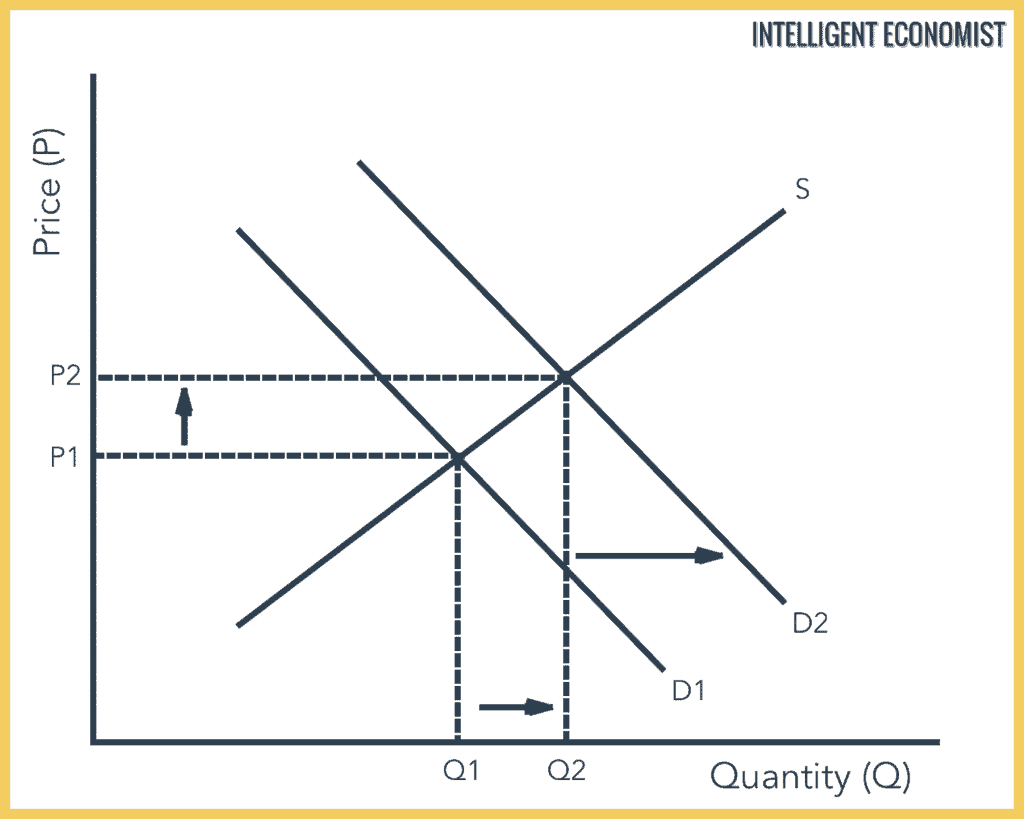The determinants of demand are factors that cause fluctuations in the economic demand for a product or a service. A shift in the demand curve occurs when the curve moves from D to D₁, which can lead to a change in the quantity demanded and the price. There are six determinants of demand.
These six factors are not the same as a movement along the demand curve, which is affected by price or quantity demanded. A shift can be an increase in demand, moves towards the right or upwards, while a decrease in demand is a shift downwards or to the left.
A Shift in the Demand Curve

In the diagram above, we see an increase in Demand. This results in the demand curve shifting from D1 to D2. This shift can occur because of any of the determinants of demand mentioned below.
Because of this demand shift, we see an increase in quantity demanded from Q1 to Q2 and an increase in price from P1 to P2.
Determinants of Demand

An increase or decrease in any of these factors affecting demand will result in a shift in the demand curve. Depending on whether it is an inward or outward shift, there will be a change in the quantity demanded and price.
1. Normal Goods
When there is an increase in the consumer’s income, there will be an increase in demand for a good. If the consumer’s income falls, then, there will be a fall in demand.
2. Change in Preferences
If there is a change in preferences, then there will be a change in demand. For example, yoga became mainstream a couple of years ago, and health enthusiasts promoted its benefits. This trend led to an increase in demand for yoga classes.
3. Complementary Goods
When there is a decrease in the price of compliments, then the demand for its compliments will increase. Complementary goods are goods you usually buy together, like bread and butter, tea and milk. If the price of one goes up, the demand for the other good will fall. For example, if the price of yoga classes fell, then there would be an increase in demand for yoga mats.
4. Substitutes
An increase in the price of substitutes will affect the demand curve. Substitutes are goods that can consumers buy in place of the other like how Coca-Cola & Pepsi are very close substitutes. If the price of one goes up, the demand for the other will rise. For example, if meditation classes became more expensive, then there would be an increase in demand for yoga classes.
5. Market Size
If the size of the market increases, like if a country’s population increases or there is an increase in the number of people in a certain age group, then the demand for products would increase. Simply put, the higher the number of buyers, the higher the quantity demanded. For example, if the birth rate suddenly skyrocketed, then there would be an increase in demand for baby products.
6. Price Expectations
When there is an expectation of a price change, this means that people expect the price of a good to increase shortly. These people are then more likely to purchase sooner, which would increase demand for the product. For example, if people are expecting the price of a laptop to fall, then they will delay their purchase until the price lowers.

